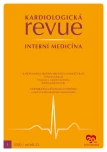Influence of physical activity on lowering blood pressure in patients with arterial hypertension
Authors:
Mikeš O. 1; Tuka V. 2
Authors‘ workplace:
III. interní klinika – klinika endokrinologie a metabolismu 1. LF UK a VFN v Praze
1; Centrum zátěžové kardiologie, 2. interní klinika – klinika kardiologie a angiologie 1. LF UK a VFN v Praze
2
Published in:
Kardiol Rev Int Med 2020, 22(1): 13-16
Overview
Along with dietary measures and weight reduction, physical activity (PA) is one of the basic non-pharmacological measures in the treatment of arterial hypertension. Observational studies have shown that men and women who regularly attend PA have a 24% and 27%, respectively, lower risk of cardiovascular disease than those who do not. Regular PA is as effective as pharmacotherapy in the treatment of arterial hypertension. The amount of systolic blood pressure reduction after physical activity depends on the systolic BP value before the onset of PA and increases in proportion to the rise in BP. The degree of BP reduction also depends on the type of physical activity that the individual performs. The basic types of PA include endurance training and resistance training. The greatest decrease in blood pressure occurs when the two types of exercise mentioned above are combined.
Keywords:
Physical activity – hypertension – non-pharmacological treatment
Sources
1. Benjamin EJ, Blaha MJ, Chiuve SE et al. Heart disease and stroke Statistics 2017. Update: a report from the American Heart Association. Circulation 2017; 135(10): e146 – e603. doi: 10.1161/ CIR.0000000000000485.
2. OECD.Health at a Glance. Available at: http:/ / oecd-library.org/ social-issues-migration-health/ health-at-a-glance_1999 2017.
3. Kantor ED, Rehm CD, Haas JS et al. Trends in Prescription drug use among adults in the United States from 1999 – 2012. JAMA 2015; 314(17): 1818 – 1831. doi: 10.1001/ jama.2015.13766.
4. Li J, Siegrist J. Physical activity and risk of cardiovascular disease – a meta-analysis of prospective cohort studies. Int J Environ Res Public Health 2012; 9(2): 391 – 407. doi: 10.3390/ ijerph9020391.
5. Murtagh EM, Nichols L, Mohammed MA et al. The effect of walking on risk factors for cardiovascular disease: an updated systematic review and meta-analysis of randomised control trials. Prev Med 2015; 72 : 34 – 43. doi: 10.1016/ j.ypmed.2014.12.041.
6. Chudyk A, Petrella RJ. Effects of exercise on cardiovascular risk factors in type 2 diabetes: a meta-analysis. Diabetes Care 2011; 34(5): 1228 – 1237. doi: 10.2337/ dc10-1881.
7. Kelley GA, Kelley KS, Franklin B. Aerobic exercise and lipids and lipoproteins in patients with cardiovascular disease: a meta-analysis of randomized controlled trials. J Cardiopulm Rehabil 2006; 26(3): 131 – 139; quiz 40 – 41, discussion 42 – 44. doi: 10.1097/ 00008483-200605000-00002.
8. Naci H, Salcher-Konrad M, Dias S et al. How does exercise treatment compare with antihypertensive medications? A network meta-analysis of 391 randomised controlled trials assessing exercise and medication effects on systolic blood pressure. Br J Sports Med 2019; 53(14): 859 – 869. doi: 10.1136/ bjsports-2018-099921.
9. Whelton PK, Carey RM, Aronow WS et al. 2017 ACC/ AHA/ AAPA/ ABC/ ACPM/ AGS/ APhA/ ASH/ ASPC/ NMA/ PCNA Guideline for the prevention, detection, evaluation, and management of high blood pressure in adults: executive summary: a report of the American College of Cardiology/ American Heart Association task force on clinical practice guidelines. Circulation 2018; 138(17): e426 – e483. doi: 10.1161/ CIR.0000000000000597.
10. Pescatello LS, Franklin BA, Fagard R et al. American College of Sports Medicine position stand. Exercise and hypertension. Med Sci Sports Exerc 2004; 36(3): 533 – 553. doi: 10.1249/ 01.mss.0000115224.88514.3a.
11. Chobanian AV, Bakris GL, Black HR et al. Seventh report of the Joint National Committee on prevention, detection, evaluation, and treatment of high blood pressure. Hypertension 2003; 42(6): 1206 – 1252. doi: 10.1161/ 01.HYP.0000107251.49515.c2.
12. Whelton PK, He J, Appel LJ et al. Primary prevention of hypertension: clinical and public health advisory from The National High Blood Pressure Education Program. JAMA 2002; 288(15): 1882 – 1888. doi: 10.1001/ jama.288.15.1882.
13. Börjesson M, Assanelli D, Carre F et al. ESC Study Group of Sports Cardiology: recommendations for participation in leisure-time physical activity and competitive sports for patients with ischaemic heart disease. Eur J Cardiovasc Prev Rehabil 2006; 13(2): 137 – 149. doi: 10.1097/ 01.hjr.0000199494.46708.5a.
14. Kokkinos P. Cardiorespiratory fitness, exercise, and blood pressure. Hypertension 2014; 64(6): 1160 – 1164. doi: 10.1161/ HYPERTENSIONAHA.114.03616.
15. Kokkinos P, Pittaras A, Narayan P et al. Exercise capacity and blood pressure associations with left ventricular mass in prehypertensive individuals. Hypertension 2007; 49(1): 55 – 61. doi: 10.1161/ 01.HYP.0000250759.71323.8b.
16. Widimský J, Filipovský J, Ceral J et al. Diagnostické a léčebné postupy u arteriální hypertenze – verze 2017. Doporučení České společnosti pro hypertenzi. Vnitř Lék 2018; 64(7 – 8): 771 – 796.
17. Tuka V. Neinvazivní kardiologie. In: Táborský M, Linhart A, Kautzner J (eds). Kardiologie. Praha: Mladá Fronta 2018.
18. Mayer-Davis EJ, D'Agostino R Jr, Karter AJ et al. Intensity and amount of physical activity in relation to insulin sensitivity: the Insulin Resistance Atherosclerosis Study. JAMA 1998; 279(9): 669 – 674. doi: 10.1001/ jama.279.9.669.
19. Choices N. Physical activity guidelines for adults. Available at: http:/ / www.nhs.uk/ live-well/ exercise.
20. Máček M, Máčková J, Radvanský J. Proč a jakou pohybovou aktivitu ve vyšším věku? Prakt Lék 2006; 86(6): 336 – 340.
Labels
Paediatric cardiology Internal medicine Cardiac surgery CardiologyArticle was published in
Cardiology Review

2020 Issue 1
Most read in this issue
- ECG diagnostic of first contact by means of eight steps
- Nicotine, smoking and cardiovascular risks – basic concepts
- Recommended examination in infectious serology in patients with cardiovascular disease
- Influence of physical activity on lowering blood pressure in patients with arterial hypertension
